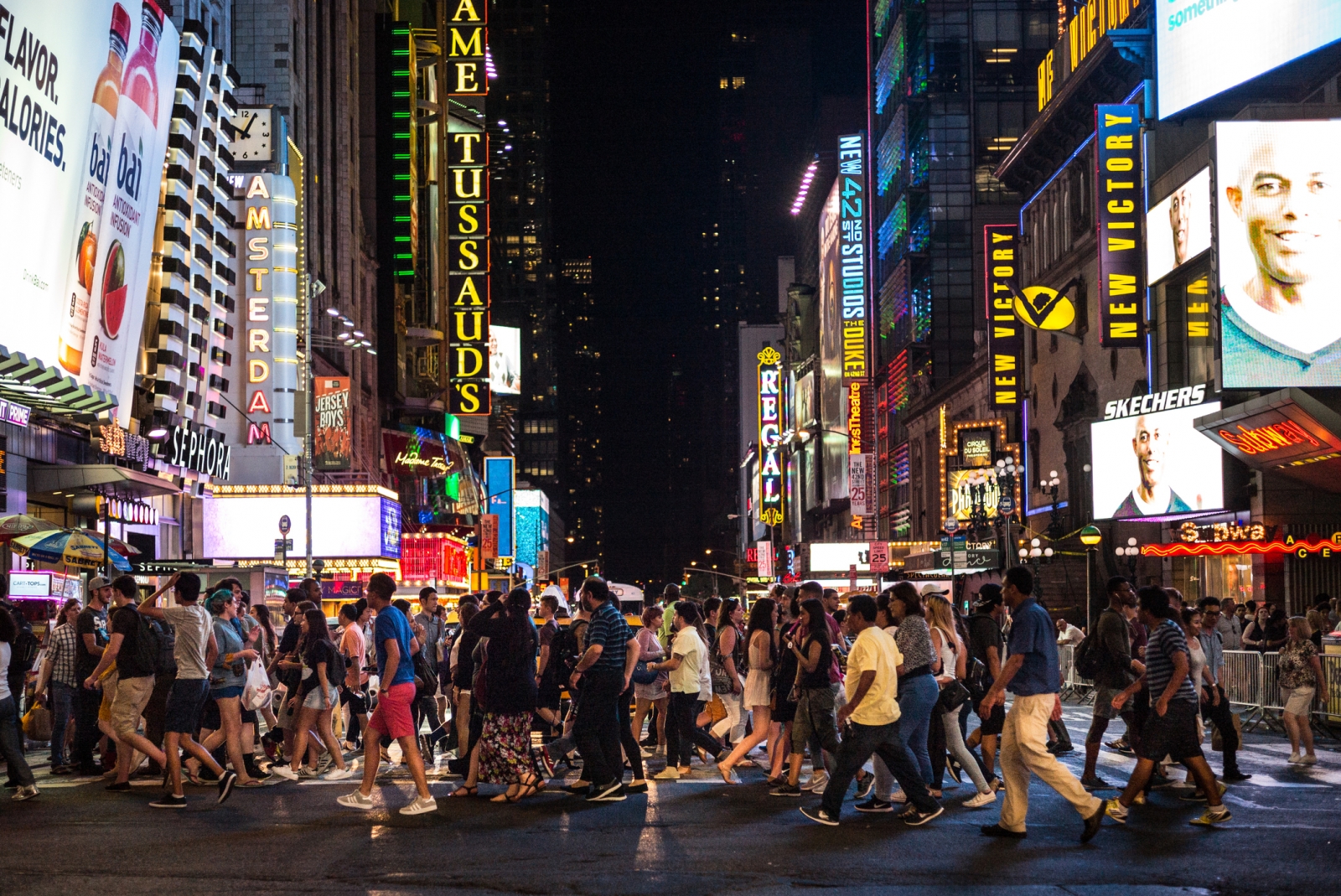
The Theater District NYC encompasses Times Square and the theaters around Broadway.
New York is a mercurial city, ever-shifting and evolving — but perhaps no neighborhood has changed as much, and as dramatically, as NYC’s Theater District. Located between West 40th Street on the south, West 54th Street on the north, Sixth Avenue to the east and Eighth Avenue to the west, the Theater District NYC has been, for many, the heart — or bane — of the entire metropolis.
How the Theater District NYC Began
In 1836, Cornelius Lawrence, the first popularly elected mayor of New York City, began urging residents to head north towards 42nd Street, proclaiming that they should “move up town and enjoy the pure, clean air.” Those were the days.
It wasn’t until the end of the 19th century that theaters and restaurants began setting their roots in what would eventually become the Theater District, following the Metropolitan Opera House’s construction at West 39th Street and Broadway in 1883. And by the time theater mogul Oscar Hammerstein I opened his vaudeville Victoria Theatre in 1899, electrified trolley lines had made the area more accessible.
Times Square, the hive-like nucleus of the Theater District, eventually took its name from the one-time residence of The New York Times at 1475 Broadway. The paper, which moved into the building on that site in 1904, moved out eight years later—but the location remains among the most valuable advertising opportunities in the world.
The New York Times building on Times Square under construction in 1903.
How Broadway in the Theater District Became ‘The Great White Way’
The Theater District has been nicknamed quite a few times — “the Rialto, “The Main Stem,” “The Street,” to name a few — but no sobriquet has stuck quite like “The Great White Way.”
In 1880, Broadway between Union Square and Madison Square was brilliantly lit by Brush arc lamps, making that stretch among the first electrically lighted streets in the country.
Shep Friedman, a columnist for the New York Morning Telegraph, dubbed it “The Great White Way” in 1901, borrowing the line from the title of a book about the Arctic.
By the 1890s, advertising signs along the route had become lit, too. When the Theater District moved uptown, the name moved with it — as did the advertisements.
Car lights on Times Square during a brownout near the end of World War II. Source: Fox Photos/Getty Images
Decline and Rebirth of the Theater District NYC
By the 1970s, much of the Theater District had become the derelict rathole of our collective memory. X-rated movies, grind houses, peep shows and drug dealers littered the blocks, and crime had increased.
NYC Theater District: A view of 42nd Street in 1980.
In 1982, Joseph Papp, a theater producer, fronted a “Save the Theaters” campaign, ultimately leading to the introduction of a bill that would have designated the district a national historic site and brought in federal financial aid.
Though Papp’s bill did not pass, the area was instead rezoned as the “Theater Subdistrict.” This reclassification allowed for monetary incentives to aid the rehabilitation and promotion of theaters.
Ten years later, Mayor Rudy Giuliani won a decisive battle for the clean-up of Times Square: the banning of “adult” entertainment in certain business districts.
The result? Times Square now averages 360,000 pedestrian visitors per day — more than 131 million per year. Some 25 Broadway theaters have been designated New York City landmarks. And it can cost up to $4 million a year to buy advertising space in the area. It’s doing just fine.
NYC’s Theater District as it looked after its revitalization.
Living in the Theater District NYC
Living in the Theater District of NYC isn’t for everyone. One of the most popular spots for tourists in the country makes, as you might expect, for unrelenting crowdedness. Traffic here is the stuff of nightmares, and if you’re a fast walker, like most New Yorkers are, then you’ll be eternally frustrated. These sidewalks are for the tourist stroll, not the commuter dash.
But if the bright lights and the big city are your cup of tea, then this might be the right place to call home — if you can afford it. The crowds assure that there’s never a dull moment, and the lights — oh, the lights — will keep you company through sleepless nights. As will the drama, the musicals, the boundless neon entertainments. The Theater District is very much the flashy New York of our dreams, for better or worse.
As for living spaces, you’re looking mostly at apartments in high-rise buildings. Studios in the broader area of Midtown Manhattan rent for a median price of $2,895 per month, while the median rent in Midtown West, which encompasses the Theater District, was $3,449 at the time of publication. The median asking price for homes in the neighborhood was $1.298 million. So this is an expensive, central location, but even here, it’s possible to find a studio apartment renting for $2,650. Of course, the other side of the coin has stunning 4.5-room condos for sale asking $2.13 million.
So if you’re looking to live in NYC’s Theater District, you won’t get a ton of space for your money. But you will be living in the beating, brightly lit heart of this vibrant city.
—
Hey, why not like StreetEasy on Facebook and follow @streeteasy on Instagram?